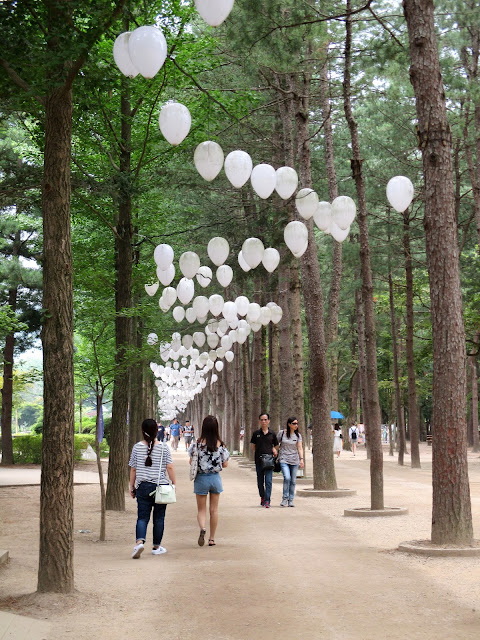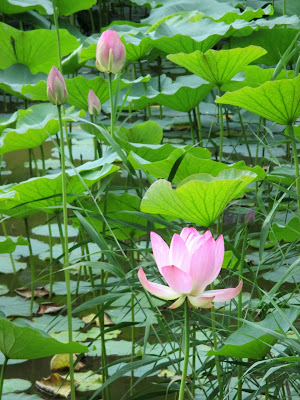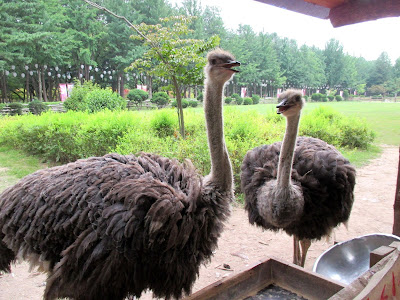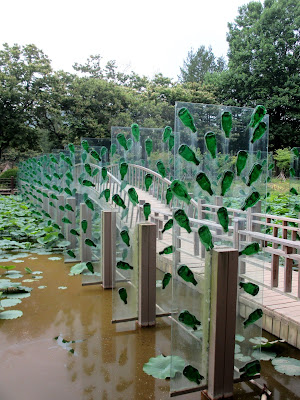Seoul's Beauty in Stillness (Part 3): Peace and Tranquility in Namiseom
Although it is not technically part of Seoul, Namiseom (a.k.a. Nami Island) is a place I would highly recommend for any tourists going to the city. It's completely doable as a day trip: just take a train to from any of Seoul's main stations (I used Yongsan) to Gapyeong (shown below), then it's just a matter of hailing a taxi.
(The island is a popular enough attraction for both locals and tourists that, even with limited or no Korean, it shouldn't be hard to tell the taxi driver where you want to go. Just bring up "Namiseom" - pronounced "Na-mee-some" - or "Nami Island" and things will work out.)
The thing about Namiseom is that, really, this is unlike any other place I visited during my trip, and there are a number of reasons why.
First of all, it is, in a way, its own little world.
Namiseom actually styles itself as a micronation called the "Naminara Republic", and attempts to make it distinct from other places in Korea are apparent right from the get-go. So, for instance, the dock from which ferries pick up visitors to transport them to the island is labelled as "Immigration". However, there is no need for passports or other such documents - although memorabilia such as Naminaran passports (which, for those who are not official citizens, function like seasons passes) available for purchase by tourists, and Namiseom has declared itself culturally independent, there is no real bureaucratic red tape to get in. Just pay for the visa (i.e. admission), and you're good.
Besides having declared itself independent, Namiseom also has the distinction of being a UNICEF Child Friendly Park, due to its close ties with the organization, as well as the general focus on childlike innocence that permeates the island's attractions.
Evidence of this connection to UNICEF is readily visible throughout Namiseom, most notably in an on-site castle, UNICEF Hall, that functions as a children's playroom and reading area.
The emphasis on the global and the international permeates other parts of Namiseom as well. This is, in terms of signage and references, the most multicultural and multilingual place I saw during my visit to Korea. Even something like a welcome sign can be jam-packed with greetings in tens of languages. It actually becomes a bit of a fun scavenger hunt to see how many references to one's home country one can find.
And, of course, I just had to search out a nod to Canada somewhere - and I found it in one of the hanging pennants.
Just a brief side comment: this probably won't apply anymore, but at the time that I was visiting, anyone from Austria would have had a huge advantage compared to tourists from anyplace else - because there was a temporary exhibit going on devoted specifically to the Classical composer Franz Joseph Haydn.
Being from a family of classical music enthusiasts, we spent way more time there than would probably have been normal for visitors to Namiseom, but that's fine by me.
It's taken me a while to get to my main point, though, so here it is: although it is definitely very bright and colourful to almost Disney-like levels, Namiseom is also a very peaceful and tranquil spot. And I think there are two main factors that made this possible.
First of all, there is nature everywhere.
Namiseom is probably most well-known for its many long, tree-lined paths. There is definitely something magical about walking down a long, perfectly straight pathway lined on both sides by equally straight and tall trees. They're equally popular with locals and foreign tourists alike, which may explain why, alongside the usual visitors, I also came across a small group of soldiers as well: were they there on some sort of training exercise, or on a day's leave? I don't know, but it made for an interesting scene - and this wasn't even the only time I came across soldiers by chance on Namiseom (more on that below).
Namiseom also featured ponds and wetlands, which could be easily traversed via bridges and walkways.
And, arguably, one of its most unusual natural features was an ostrich petting zoo. I didn't try feeding them or touching them, having seen footage from Korean variety shows that suggest the birds could get rather aggressive in their eagerness for food. But, that meant that I did know to keep an eye open for them all the same.
And it is this slight touch of the bizarre that I would argue is the second main reason why Namiseom can be a peaceful and tranquil place. There is an inherent childlike innocence in how the island's attractions are made and constructed: everything from small child-sized houses to the ubiquitous snowman sculptures (a nod to Namiseom's fame as a filming location for the classic Korean drama, Winter Sonata).
A couple of highlights I want to draw your attention to:
As I've previously mentioned, Namiseom is an immensely popular tourist attraction due to the fact that it was used as a filming location for the Korean drama, Winter Sonata. So, while I was on the island, I would say that its busiest part would be the section devoted specifically to the drama, as people will queue up for souvenir photos here. A particular popular attraction in this part is the sculpture of the drama's main protagonists:
The other interesting detail I want to point out before I go is that Namiseom also has its fair share of kitschy arts and crafts stores and restaurants. Visitors could have a proper sit-down meal, or just quickly buy a steamed bun filled with sweet red bean paste, still cooked in the old-fashioned way in a cast iron pot over a wood fire.
It was in one of these areas that I found something I found absolutely adorable: benches with a built-in cupboard filled with children's books.
The first one I spotted is the one in the first photo here, but I didn't want to get too close to photograph it, lest I disturb the group of soldiers just beyond it. Not that I was afraid of them or anything; I'm just enough of an introvert that if I could get up close to one that didn't have any people around, I would.
Fortunately, I did find one a short distance away that was just by itself without any crowds, and actually was able to photograph it to my hearts' content.
Now, I do want to make one thing clear: Namiseom can and will get crowded at times. It is, after all, a very popular attraction for both domestic and overseas tourists. However, that being said, the fact that it is a sizable island helps in creating a sense of stillness and calm: it's not that hard to find places with few or no people around, as I hoped these photographs were able to show. Also, there is something just so pure and innocent about its natural beauty and its childish aesthetic that really makes Namiseom a difficult place to forget.
What's Next?
This, unfortunately, is the end of my "Seoul's Beauty in Stillness" series.
However, not to worry: this is not the end of the "Beauty in Stillness" concept as a whole. I will be back with similar posts for other cities and locations that I have visited, so stay tuned!
Resources
Naminara, 2015, https://namisum.com/en/. Accessed 9 December, 2017.
Image Credits
All photographs (c) Kitty Na

















































Comments
Post a Comment